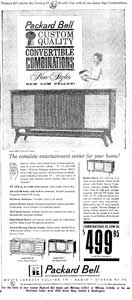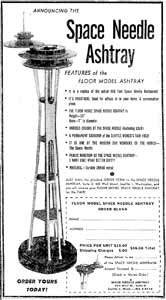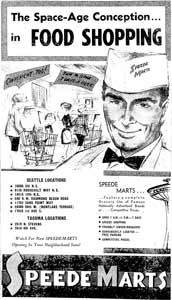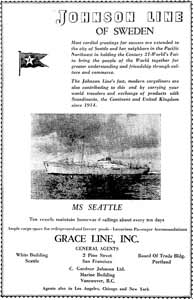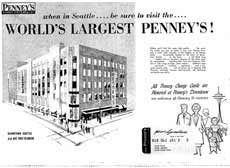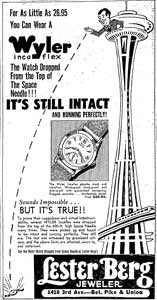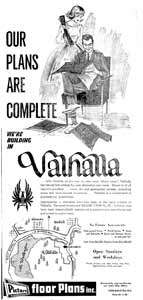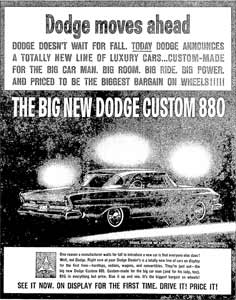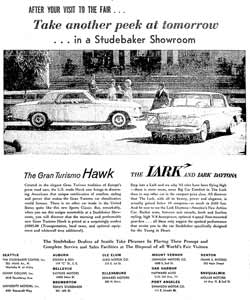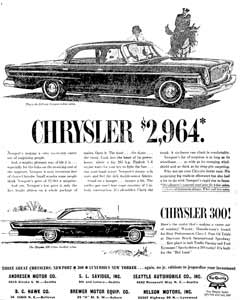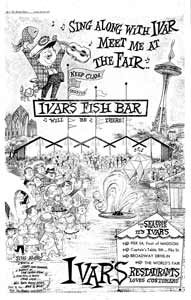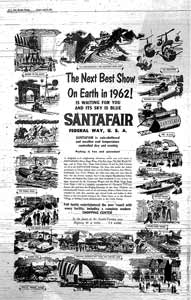Pages from the April 8, 1962 edition of the Seattle Times, a Seattle World's Fair Souvenir Edition.
February 9, 2012 at 4:42 PM
Selected ads from 1962 souvenir World's Fair section
February 8, 2012 at 10:36 AM
All 152 pages from souvenir section in PDFs
Previous: A hat tip to Alaska, fresh off statehood | Next: Selected ads from 1962 World's Fair section
Previous: A hat tip to Alaska, fresh off statehood | Next: Selected ads from 1962 World's Fair section
February 5, 2012 at 5:47 PM
A hat tip to Alaska, fresh off statehood
Previous: A cross-Sound bridge? A highway around Lake Washington? | Next: All 152 pages from souvenir section in PDFs

Previous: A cross-Sound bridge? A highway around Lake Washington? | Next: All 152 pages from souvenir section in PDFs
February 5, 2012 at 5:42 PM
A cross-Sound bridge? A highway around Lake Washington?
Previous: Custom-made for the big car man | Next: A hat tip to Alaska, fresh off statehood
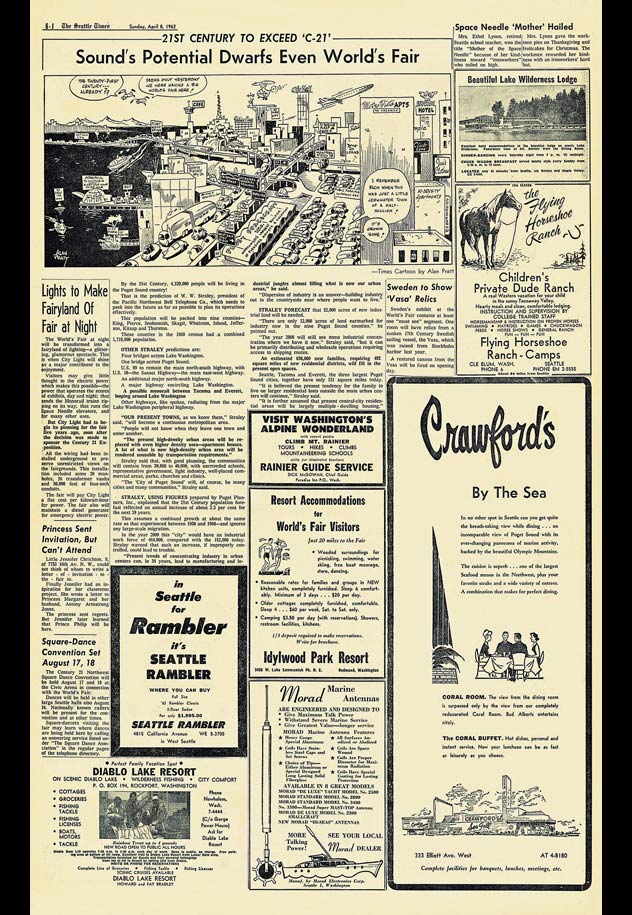
Previous: Custom-made for the big car man | Next: A hat tip to Alaska, fresh off statehood
Published April 8, 1962:
Sound's Potential Dwarfs Even World's Fair
By the 21st Century, 4,320,000 people will be living in the Puget Sound country!
That is the prediction of W.W. Straley, president of the Pacific Northwest Bell Telephone Co., which needs to peek into the future as far as possible to plan its operations effectively.
This population will be packet into nine counties - King, Pierce, Snohomish, Skagit, Whatcom, Island, Jefferson, Kitsap and Thurston.
These counties in the 1960 census had a combined 1,718,900 population.
OTHER STRALEY predictions are:
- Four bridges across Lake Washington.
- One bridge across Puget Sound.
- U.S. 99 to remain the main north-south highway, with U.S. 10 - the Sunset Highway - the main east-west highway.
- An additional major north-south highway.
- A major highway encircling Lake Washington.
- A possible monorail between Tacoma and Everett, looping around Lake Washington.
- Other highways, like spokes, radiating from the major Lake Washington peripheral highway.
"OUR PRESENT TOWNS, as we know them," Straley said, "will become a continuous metropolitan area.
"People will not know when they leave one town and enter another.
"The present high-density urban areas will be replaced with even higher density uses - apartment houses. A lot of what is now high-density urban area will be rendered unusable by transportation requirements."
Straley said that, with good planning, the communities will contain from 30,000 to 40,000, with uncrowded schools, representative government, light industry, well-placed commercial areas, parks, churches and clinics.
"The 'City of Puget Sound' will, of course, be many cities and many communities," Straley said.
STRALEY, USING FIGURES prepared by Puget Planners, Inc., explained that the 21st Century population forecast reflected an annual increase of about 2.3 percent for the next 38 years.
This assumes a continued growth at the same rate as that experienced between 1950 and 1960 - and ignores any large-scale migration.
In the year 2000 this "city" would have an industrial work force of 464,000, compared with the 182,000 today. Straley warned that such an increase, if improperly controlled, could lead to trouble.
"Present trends of concentrating industry in urban centers can, in 38 years, lead to manufacturing and industrial jungles almost filling what is now our urban areas," he said.
"Dispersion of industry is an answer - building industry out in the countryside near where people want to live."
STRALEY FORECAST that 52,000 acres of new industrial land will be needed.
"There are only 12,000 acres of land earmarked for industry now in the nine Puget Sound counties," he pointed out.
"The year 2000 will still see some industrial concentration where we have it now," Straley said, "but it can be primarily distributing and wholesale operations requiring access to shipping routes.
An estimated 656,000 new families, requiring 492 square miles of new residential districts, will fill in the present open spaces.
Seattle, Tacoma and Everett, the three largest Puget Sound cities, together have only 151 square miles today.
"It is believed the present tendency for the family to live on larger residential lots outside the main urban centers will continue," Straley said.
"It is further assumed that present central-city residential areas will be largely multiple-dwelling housing."
February 5, 2012 at 5:38 PM
Custom-made for the big car man
Previous: Fair's effect on travel, recreation | Next: A cross-Sound bridge? A highway around Lake Washington?
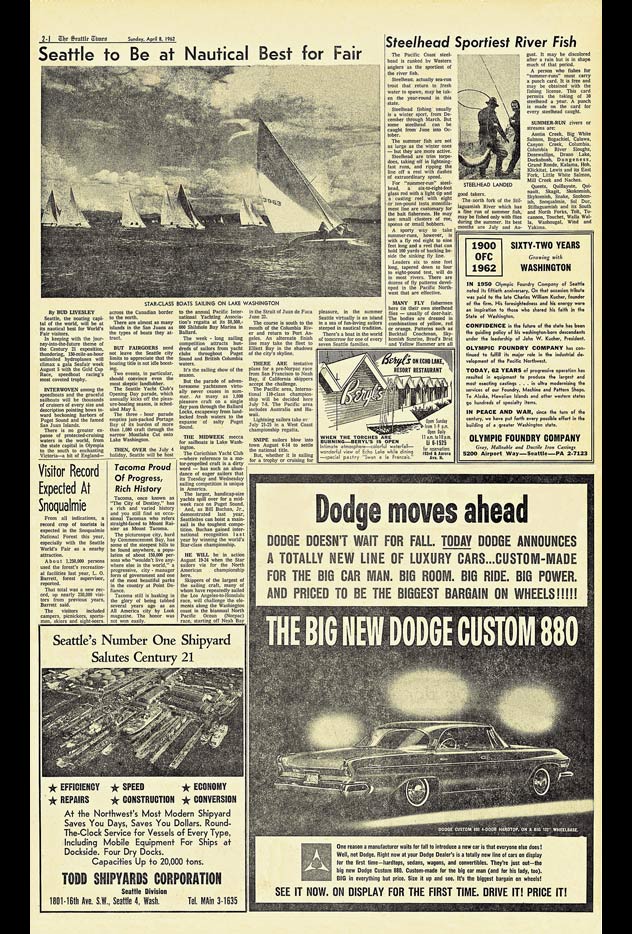
Previous: Fair's effect on travel, recreation | Next: A cross-Sound bridge? A highway around Lake Washington?
February 5, 2012 at 5:30 PM
Fair's effect on travel, recreation
Previous: Boeing sees big future in space | Next: Custom-made for the big car man
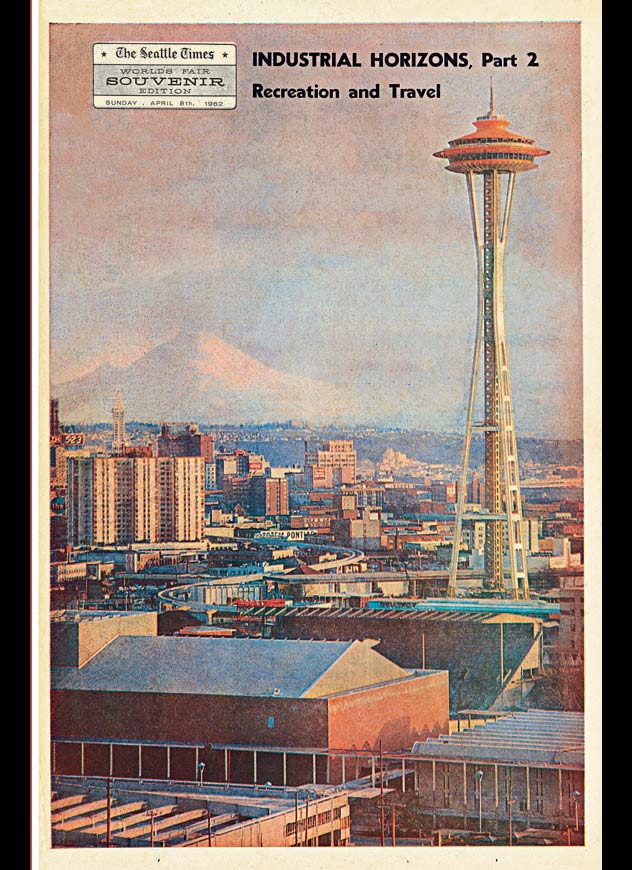
Previous: Boeing sees big future in space | Next: Custom-made for the big car man
February 5, 2012 at 5:26 PM
Boeing sees big future in space
Previous: Region's technology development touted | Next: Fair's effect on travel, recreation
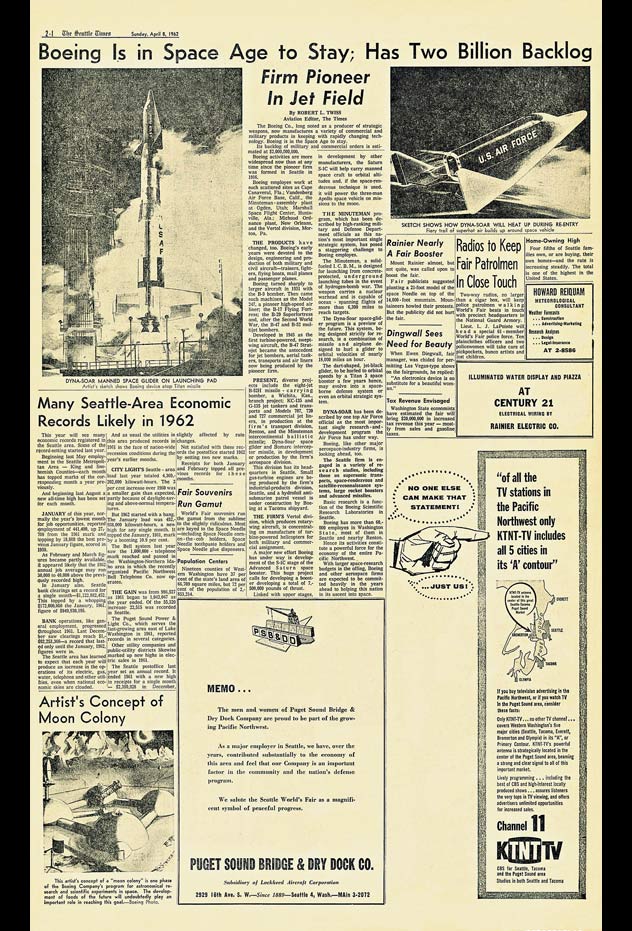
Previous: Region's technology development touted | Next: Fair's effect on travel, recreation
Published April 8, 1962:
Boeing Is in Space Age to Stay; Has Two Billion Backlog
By Robert L. Twiss
Aviation Editor, The Times
The Boeing Co., long noted as a producer of strategic weapons, now manufactures a variety of commercial and military products. In keeping with rapidly changing technology, Boeing is in the Space age to stay.
Its backlog of military and commercial orders is estimated at $2,000,000,000.
Boeing activities are more widespread now than at any time since the pioneer firm was formed in Seattle in 1910.
Boeing employees work at such scattered sites as Cape Canaveral, Fla.; Vandenberg Air Force Base, Calif.; the Minuteman assembly plant at Ogden, Utah; Marshall Space Flight Center, Huntsville, Ala.; Michoud Ordnance plant, New Orleans; and the Vertol division, Morton, Pa.
THE PRODUCTS have changed, too. Boeing's early years were devoted to the design, engineering and production of both military and civil aircraft - trainers, fighters, flying boats, mail planes and passenger planes.
Boeing turned sharply to larger aircraft in 1931 with the B-9 bomber. Then came such machines as the Model 247, a pioneer high-speed airliner; the B-17 Flying Fortress; the B-29 Superfortress; and, after the Second World War, the B-47 and B-52 multijet bombers.
Developed in 1945 as the first turbine-powered, sweptwing aircraft, the B-47 Stratojet became the antecedent for jet bombers, aerial tankers, transports and air liners now being produced by the pioneer firm.
PRESENT, diverse projects include the eight-jet B-52H missile-carrying bomber, a Wichita, Kan., branch project; KC-135 and G-135 jet tankers and transports and Models 707, 720 and 727 commercial jet liners, in production at the firm's transport division, Renton, and the Minuteman Intercontinental ballistic missile; Dyna-Soar space glider and Bomarc interceptor missile, in development or production by the firm's aerospace division.
This division has its headquarters in Seattle. Small gas-turbine engines are being produced by the firm's industrial products division, Seattle, and a hydrofoil anti-submarine patrol vessel is under construction by Boeing at a Tacoma shipyard.
THE FIRM'S Vertol division, which produces rotary-wing aircraft, is concentrating on manufacture of turbine-powered helicopters for both military and commercial assignment.
A major new effort Boeing has under way is development of the S-1C stage of the advanced Saturn space booster. This huge project calls for developing a booster developing a total of 7,500,000 pounds of thrust.
Linked with upper stages, in development by other manufacturers, the Saturn S-1C will help carry manned space craft to orbital altitudes and, if the space-rendezvous technique is used, it will power the three-man Apollo space vehicle on missions to the moon.
THE MINUTEMAN program, which has been described by high-ranking military and Defense Department officials as the nation's most important single strategic system, has posed a staggering challenge to Boeing employees.
The Minuteman, a solid-fueled I.C.B.M., is designed for launching from concrete-protected, underground launching tubes in the event of hydrogen-bomb war. The weapon carries a nuclear warhead and is capable of ocean-spanning flights of more than 8,300 miles to reach targets.
The Dyna-Soar space-gliders program is a preview of the future. This system, being designed strictly for research, is a combination of missile and airplane designed to hurl a glider to orbital velocities of nearly 18,000 miles an hour.
The dart-shaped, jet-black glider, to be hurled to orbital speeds by a Titan 3 space booster a few years hence, may evolve into a space-borne defense system or even an orbital strategic system.
DYNA-SOAR has been described by one top Air Force official as the most important single research-and-development program the Air Force has under way.
Boeing, like other major aerospace-industry firms, is looking ahead, too.
The Seattle firm is engaged in a variety of research studies, including those on supersonic transports, space-rendezvous and satellite-reconnaissance systems, large rocket boosters and advanced missiles.
Basic research is a function of the Boeing Scientific Research Laboratories in Seattle.
Boeing has more than 60,000 employees in Washington state, most them in Seattle and nearby Renton.
Hence its activities constitute a powerful force for the economy of the entire Pacific Northwest.
With larger space-research budgets in the offing, Boeing and other aerospace firms are expected to be committed heavily in the years ahead to helping this nation in its ascent into space.
February 5, 2012 at 5:18 PM
Region's technology development touted
Previous: On the brink of swift urbanization | Next: Boeing sees big future in space
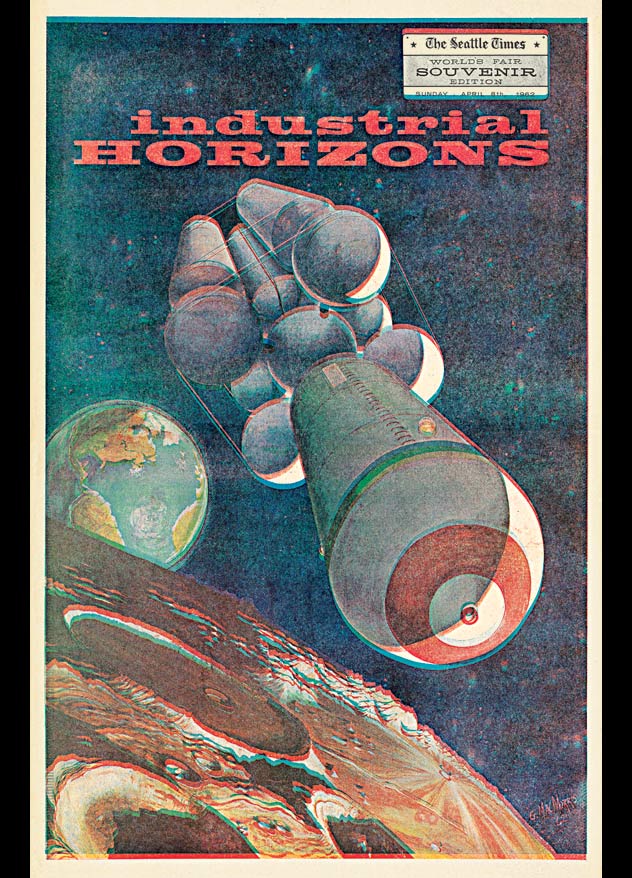
Previous: On the brink of swift urbanization | Next: Boeing sees big future in space


general classifieds
Garage & estate salesFurniture & home furnishings
Electronics
just listed
More listings
POST A FREE LISTING







